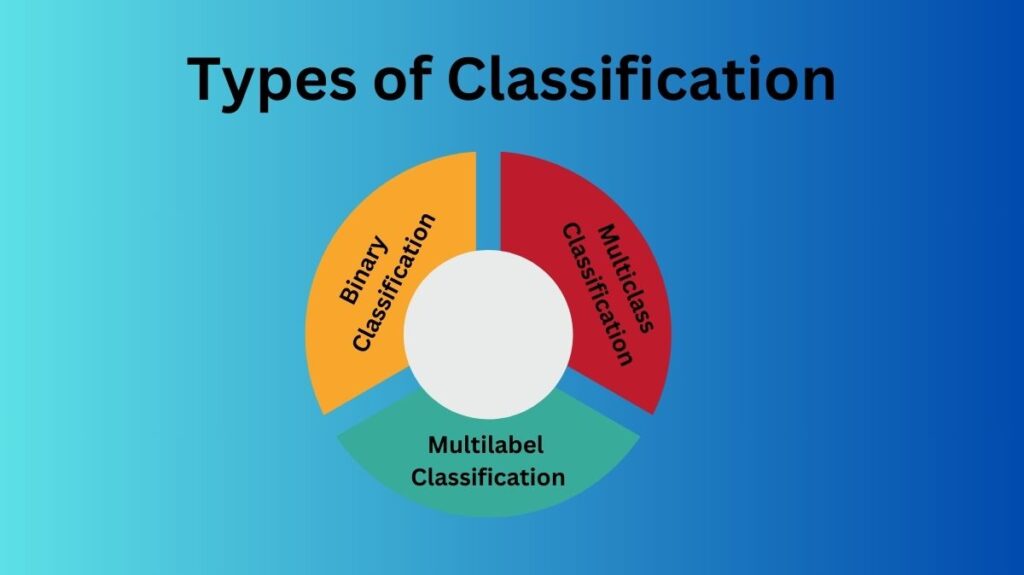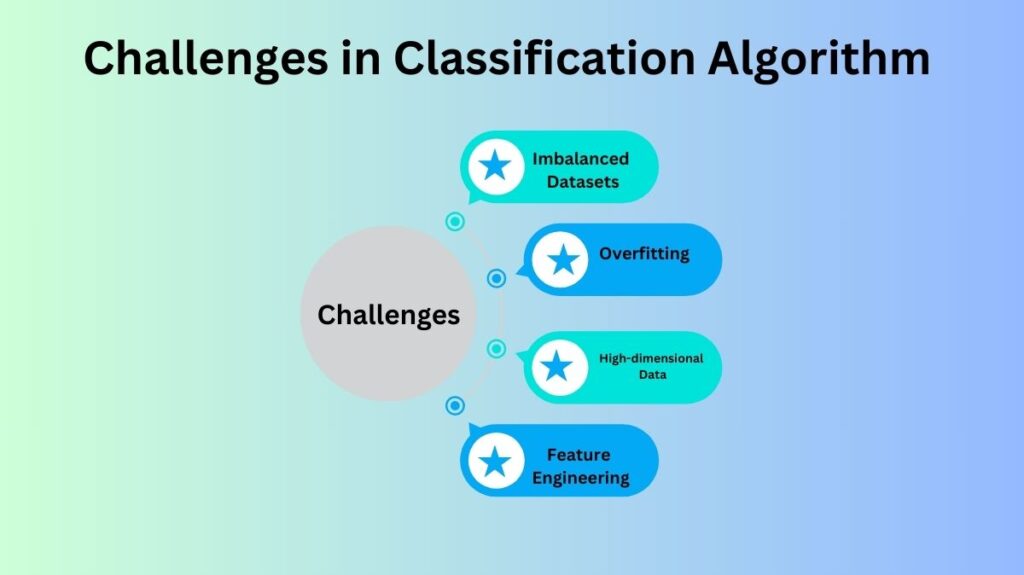Classification algorithms are essential to machine learning (ML) because they classify data. These supervised learning algorithms require labeled data to train the model. The program can predict class labels for fresh data after training on labeled data. Applications including email spam detection, sentiment analysis, image recognition, medical diagnosis, and more have classification challenges.
Classification issues, algorithms, working principles, types, evaluation metrics, and practical applications will be covered in this detailed discussion.
What is Classification Algorithm?
Using input features, classification is a supervised machine learning problem that predicts data point categorization. Each instance in the training set is labeled, and the classifier must learn a mapping from input features to labels.
For example:
- Classifying emails as “spam” or “not spam.”
- Medical diagnosis: Predicting a patient’s ailment based on age, gender, and test findings (“diseased” or “healthy”).
- Recognizing images as “cat,” “dog,” “bird,” etc.
Types of Classification Algorithm Problems

- Binary Classification: The simplest classification is binary classification, which has two classes. Example: predicting spam email.
- Multiclass Classification: Classification with more than two classes. Example: categorizing fruits by color, shape, and texture as “apple,” “banana,” or “orange.”
- Multilabel Classification: Each instance can belong to numerous classes in multilabel classification. A film can be “action,” “comedy,” and “drama” at once.
Important Classification Algorithms
Classification methods vary by data and task. Here are some popular classification algorithms:
Logistic Regression:
Although called “regression,” logistic regression is mostly employed for binary categorization. It estimates an input’s class probability. The technique fits data to a sigmoid logistic function. Probability is the output value between 0 and 1.
- Strengths: Easy to interpret, efficient for small datasets.
- Weaknesses: assumes a linear relationship between characteristics and result log-odds, which may not be true.
Decision Trees:
The best feature (typically Gini impurity or entropy) is used to recursively break the dataset into subsets by decision trees, a non-linear classification approach. The resulting tree-like structure represents feature decisions as internal nodes and class labels as leaf nodes.
- Strengths: Fast training, easy interpretation, handles numerical and categorical data.
- Weaknesses: Overfitting, noisy data are weaknesses.
Random Forest:
Multiple decision trees are used in random forest to improve classification accuracy. Bootstrapping and a random subset of features at each node create a forest of decision trees.
- Strengths: Capable of handling missing values and overfitting, suited for high-dimensional data.
- Weaknesses: Number of trees makes it computationally expensive and hard to interpret.
Support Vector Machines (SVM):
The sophisticated classification method SVM finds a hyperplane that best separates data points of different classes. It maximizes class margin and minimizes classification errors. Kernel tricks let SVMs classify linear and non-linear problems.
- Strengths: Works effectively in high-dimensional spaces with obvious division.
- Weaknesses: Memory-intensive, kernel and parameter-sensitive.
k-Nearest Neighbors (k-NN):
Basic and intuitive, k-NN classifies a new data point by evaluating the k-nearest neighbors in the training data. The new instance’s anticipated class is the most common neighboring class.
- Strengths: Simple, no training, works well with tiny datasets.
- Weaknesses: Uncertainty about k and distance metric, computationally expensive forecast.
Naive Bayes:
Based on Bayes’ theorem, Naive Bayes classifiers assume characteristics are conditionally independent given class labels. Naive Bayes regularly surprises in text categorization and other problems despite its “naive” assumption of independence.
- Strengths: Fast, simple, and works with text and feature independence.
- Weaknesses: Performance can be limited by the assumption of feature independence in real-world data.
Artificial Neural Networks (ANN):
Modeled after the human brain, ANNs are algorithms. With weighted sums and activation functions, layers of interconnected neurons convert input data into output. A neural network may learn complicated patterns and relationships.
- Strengths: Highly effective for non-linear issues, huge datasets, and complex data like photos and text.
- Weaknesses: It requires enormous datasets, is computationally expensive, and uninterpretable.
Gradient Boosting Machines (GBM):
GBM is another ensemble method that creates decision trees progressively, correcting past errors. It enhances model accuracy over time. XGBoost and LightGBM are popular.
Strengths: Handles unbalanced data well, high predicting accuracy.
Weaknesses: Expensive computation, overfitting without adjustment.
Classification Algorithm evaluation metrics
Using proper criteria, classifier performance must be assessed after training. Most classification evaluation metrics are:
- Accuracy: The percentage of accurately classified instances. With skewed datasets, accuracy can be deceiving despite its simplicity.
- Precision: Percentage of anticipated positives that are true. It is important in spam detection, when false positives are costly.
- Sensitivity (Recall): Percentage of true positive forecasts to all positives. For expensive false negatives (e.g., medical diagnostics), it is crucial.
- F1-Score: Precision-recall harmonic mean. It balances precision and recollection, useful in class imbalances.
- Confusion Matrix: A confusion matrix depicts a classifier’s true positives, true negatives, false positives, and false negatives.
- ROC Curve and AUC: The ROC curve compares true and false positive rates at different thresholds, whereas the AUC measures the classifier’s ability to differentiate classes.
Challenges in Classification Algorithm

- Imbalanced Datasets: Classifiers may favor the dominant class, resulting in inferior performance for the minority class.
- Overfitting: A model that learns noise in training data than generalizable patterns may perform well on training data but badly on unseen data.
- High-dimensional Data: The “curse of dimensionality.” occurs when the model cannot discern meaningful patterns from high-dimensional data.
- Feature Engineering: Selecting categorization features is difficult and time-consuming, affecting model performance.
Applications of Classification Algorithms
- Email Spam Filtering: Using sender, subject, and content to classify emails as spam or not.
- Medical diagnosis: Predicting disease based on patient data.
- Sentiment Analysis: Customer reviews and social media posts are analyzed for positive, negative, or neutral sentiment.
- Image Recognition: Identifying cats, dogs, and cars in pictures using image recognition.
- Financial Fraud Detection:Detecting financial fraud using user behavior and transaction facts.
Conclusion
Machine learning requires classification algorithms to predict discrete outcomes from input features. The task, data, and performance requirements determine the classifier, from logistic regression to deep learning. Practitioners can choose the best classification algorithm for their task by understanding its strengths and weaknesses, resulting in more effective and dependable models.
